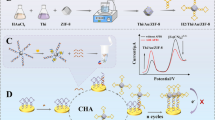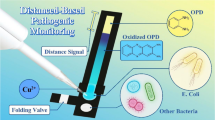Abstract
The authors describe a label-free electrochemical aptasensor for tetracycline (TET). The TET-binding aptamer was immobilized on a composite consisting of reduced graphene oxide, magnetite (Fe3O4) and sodium alginate, and this material was used to modify the surface of a screen-printed carbon electrode (SPCE). Cyclic voltammetry was carried out to characterize the single steps in the preparation of the modified electrode and to optimize the conditions for detection. Differential pulse voltammetry (DPV) was then used to monitor the interaction between aptamer and TET by applying the electrochemical probe thionine. Under optimal conditions, TET can be quantified by DPV in the 1 nM to 5 μM concentration range, with a detection limit as low as 0.6 nM (at an S/N ratio of 3). The method is rapid, cost-efficient, highly sensitive and specific, and therefore is considered to be a viable platform for TET analysis in food, environmental, and clinical samples.

The electrochemical aptasensor for TET is based on the use of a screen-printed carbon electrode modified with reduced graphene oxide, Fe3O4 nanoparticles and sodium alginate, and using thionine (Thi) as an electrochemical probe




Similar content being viewed by others

References
Fritz J, Zuo Y (2007) Simultaneous determination of tetracycline, oxytetracycline, and 4-epitetracycline in milk by high-performance liquid chromatography. Food Chem 105(3):1297–1301
Sassman SA, Lee L (2005) Sorption of three tetracyclines by several soils assessing the role of pH and cation exchange. Environ Sci Technol 39:7452–7459
Sarmah AK, Meyer MT, Boxall AB (2006) A global perspective on the use, sales, exposure pathways, occurrence, fate and effects of veterinary antibiotics (VAs) in the environment. Chemosphere 65(5):725–759
Hamscher G, Pawelzick HT, Höper H, Nau H (2005) Different behavior of tetracyclines and sulfonamides in sandy soils after repeated fertilization with liquid manure. Environ Toxicol Chem 24(4):861–868
Wu N, Qiao M, Zhang B, Cheng WD, Zhu YG (2010) Abundance and diversity of tetracycline resistance genes in soils adjacent to representative swine feedlots in China. Environ Sci Technol 44(18):6933–6939
Shentu JL, Zhang K, Shen DS, Wang MZ, Feng HJ (2015) Effect from low-level exposure of oxytetracycline on abundance of tetracycline resistance genes in arable soils. Environ Sci Pollut Res Int, Press. doi:10.1007/s11356-015-4099-1
Jin H, Kumar AP, Paik DH, Ha KC, Yoo YJ, Lee YI (2010) Trace analysis of tetracycline antibiotics in human urine using UPLC-QToF mass spectrometry. Microchem J 94(2):139–147
Zhang Y, Lu S, Liu W, Zhao C, Xi R (2007) Preparation of anti-tetracycline antibodies and development of an indirect heterologous competitive enzyme-linked immunosorbent assay to detect residues of tetracycline in milk. J Agric Food Chem 55(2):211–218
Nagel OG, Molina MP, Althaus RL (2011) Optimization of bioassay for tetracycline detection in milk by means of chemometric techniques. Lett Appl Microbiol 52(3):245–252
Yudthavorasit S, Chiaochan C, Leepipatpiboon N (2011) Simultaneous determination of multi-class antibiotic residues in water using carrier-mediated hollow-fiber liquid-phase microextraction coupled with ultra-high performance liquid chromatography tandem mass spectrometry. Microchim Acta 172(1–2):39–49
Townshend A, Ruengsitagoon W, Thongpoon C, Liawruangrath S (2005) Flow injection chemiluminescence determination of tetracycline. Anal Chim Acta 541(1–2):103–109
Rodriguez JA, Espinosa J, Aguilar-Arteaga K, Ibarra IS, Miranda JM (2010) Determination of tetracyclines in milk samples by magnetic solid phase extraction flow injection analysis. Microchim Acta 171(3–4):407–413
Ferreira CS, Matthews CS, Missailidis S (2006) DNA aptamers that bind to MUC1 tumour marker: design and characterization of MUC1-binding single-stranded DNA aptamers. Tumour Biol 27(6):289–301
Velasco-Garcia M, Missailidis S (2009) New trends in aptamer-based electrochemical biosensors. Gene Ther Mol Biol 13:1–10
Xue F, Wu J, Chu H, Mei Z, Ye Y, Liu J, Zhang R, Peng C, Zheng L, Chen W (2012) Electrochemical aptasensor for the determination of bisphenol a in drinking water. Microchim Acta 180(1–2):109–115
Wu S, Duan N, Shi Z, Fang C, Wang Z (2014) Simultaneous aptasensor for multiplex pathogenic bacteria detection based on multicolor upconversion nanoparticles labels. Anal Chem 86(6):3100–3107
Shen B, Li J, Cheng W, Yan Y, Tang R, Li Y, Ju H, Ding S (2015) Electrochemical aptasensor for highly sensitive determination of cocaine using a supramolecular aptamer and rolling circle amplification. Microchim Acta 182(1–2):361–367
Zhang H, Shuang S, Sun L, Chen A, Qin Y, Dong C (2013) Label-free aptasensor for thrombin using a glassy carbon electrode modified with a graphene-porphyrin composite. Microchim Acta 181(1–2):189–196
Gao F, Lei J, Ju H (2013) Label-free surface-enhanced Raman spectroscopy for sensitive DNA detection by DNA-mediated silver nanoparticle growth. Anal Chem 85(24):11788–11793
Du Y, Li B, Wang F, Dong S (2009) Au nanoparticles grafted sandwich platform used amplified small molecule electrochemical aptasensor. Biosens Bioelectron 24(7):1979–1983
Robinson JT, Perkins FK, Snow ES, Wei Z, Sheehan PE (2008) Reduced graphene oxide molecular sensors. Nano Lett 8(10):3137–3140
Zhou M, Zhai Y, Dong S (2009) Electrochemical sensing and biosensing platform based on chemically reduced graphene oxide. Anal Chem 81:5603–5613
Yang J, Deng S, Lei J, Ju H, Gunasekaran S (2011) Electrochemical synthesis of reduced graphene sheet-AuPd alloy nanoparticle composites for enzymatic biosensing. Biosens Bioelectron 29(1):159–166
Wu ZS, Yang S, Sun Y, Parvez K, Feng X, Mullen K (2012) 3D nitrogen-doped graphene aerogel-supported Fe3O4 nanoparticles as efficient electrocatalysts for the oxygen reduction reaction. J Am Chem Soc 134(22):9082–9085
Ye Y, Kong T, Yu X, Wu Y, Zhang K, Wang X (2012) Enhanced nonenzymatic hydrogen peroxide sensing with reduced graphene oxide/ferroferric oxide nanocomposites. Talanta 89:417–421
Dong Y, Zhang H, Rahman ZU, Su L, Chen X, Hu J, Chen X (2012) Graphene oxide-Fe3O4 magnetic nanocomposites with peroxidase-like activity for colorimetric detection of glucose. Nanoscale 4:3969–3976
Shi W, Zhu J, Sim DH, Tay YY, Lu Z, Zhang X, Sharma Y, Srinivasan M, Zhang H, Hng HH, Yan Q (2011) Achieving high specific charge capacitances in Fe3O4/reduced graphene oxide nanocomposites. J Mater Chem 21:3422–3427
Cao KC (2015) Preparation of graphene/graphene based hybrid material by microwave assisted methods and the control of defect in graphene. Sichuan University, Chengdu, China, Master thesis
Niazi JH, Lee SJ, Gu MB (2008) Single-stranded DNA aptamers specific for antibiotics tetracyclines. Bioorg Med Chem 16(15):7245–7253
Zhao G, Zhan X (2010) Facile preparation of disposable immunosensor for shigella flexneri based on multi-wall carbon nanotubes/chitosan composite. Electrochim Acta 55(7):2466–2471
Yang S, Feng X, Ivanovici S, Müllen K (2010) Fabrication of graphene-encapsulated oxide nanoparticles: towards high-performance anode materials for lithium storage. Angew Chem Int Ed 49:8408–8411
Song S, Wang L, Li J, Fan C, Zhao J (2008) Aptamer-based biosensors. Trends Anal Chem 27(2):108–117
Zhou L, Li DJ, Gai L, Wang JP, Li YB (2012) Electrochemical aptasensor for the detection of tetracycline with multi-walled carbon nanotubes amplification. Sensors Actuators B Chem 162(1):201–208
Chen D, Yao D, Xie C, Liu D (2014) Development of an aptasensor for electrochemical detection of tetracycline. Food Control 42:109–115
Guo Y, Wang X, Sun X (2015) A label-free electrochemical aptasensor based on electrodeposited gold nanoparticles and methylene blue for tetracycline detection. Int J Electrochem Sci 10:3668–3679
Acknowledgments
This work was supported by the National High Technology Research and Development Program (“863” Program) of China (No. 2012AA101405), Morningstar Fund of Shanghai Jiaotong University (No. 13X100010018), 1000-Talent Program (Recruitment Program of Global Expert, In Chinese: Qian-Ren-Ji-Hua) and Director Foundation of XTIPC, CAS (No. 2015RC012). We thank Kecheng Cao of Sichuan University for providing the rGO-Fe3O4 and helpful discussions. We also thank Bin Chen of Shanghai Jiaotong University for TEM, HRTEM and EDS analyses.
Author information
Authors and Affiliations
Corresponding author
Electronic supplementary material
ESM 1
(DOC 720 kb)
Rights and permissions
About this article
Cite this article
Zhan, X., Hu, G., Wagberg, T. et al. Electrochemical aptasensor for tetracycline using a screen-printed carbon electrode modified with an alginate film containing reduced graphene oxide and magnetite (Fe3O4) nanoparticles. Microchim Acta 183, 723–729 (2016). https://doi.org/10.1007/s00604-015-1718-y
Received:
Accepted:
Published:
Issue Date:
DOI: https://doi.org/10.1007/s00604-015-1718-y



